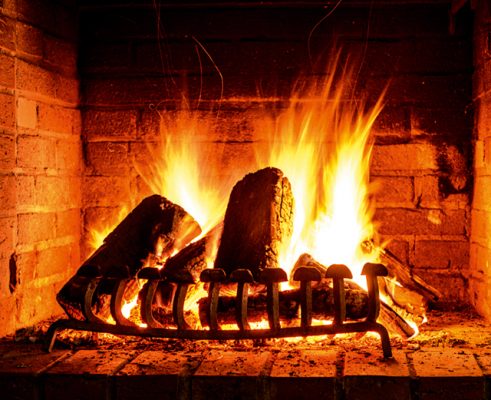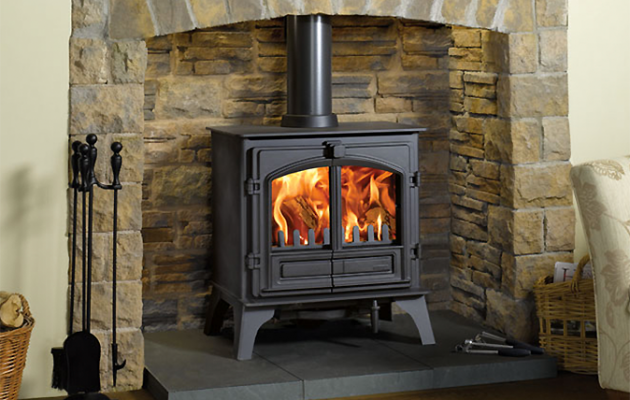Wood-burning stove or open fire? Arabella Youens examines the pros and cons of both options.
In the country, most houses need a powerful source of heat in the depths of winter to boost or counter the cost of having the central heating on all day. However, the role of fire isn’t just about warmth; there’s no doubt that dancing flames – in an open grate or behind a glass – is a sure-fire way of bringing atmosphere into a room.
As interior decorator Emma Sims-Hilditch says: ‘Fireplaces appeal to all the senses, with the illumination of a flame lighting a room on a cold winter’s evening and smoke gently pluming out of the chimney. There’s nothing more inviting than returning home from a walk to a gently burning fire.’
Emma Burns of Sybil Colefax & John Fowler goes as far to say that a room isn’t ‘complete’ without a fireplace or stove. She’s a particular advocate of the tiled stoves used throughout Northern Europe and Russia, having recently installed one, covered in intense blue ceramic tiles, in the upstairs room of a log building. ‘I like fires burning in grates all year round – the flickering flames give such life to a room.’
Open fires: The pros and cons
- Unbeatable for ambience
- Sets a tone throughout the house
- Ideal for a traditional drawing room
- Very inefficient for heating — though there are measures that can help

The warmth from a roaring log fire permeates the entire house with a delicious aroma – aficionados can get quite obsessive about which wood cocktail creates the best results, including apple, pear and cherry or, if you can get it, olive, which has an excellent slow burn with a hint of the Mediterranean.
The fireplace in full splendour also acts as the focal point of the room, drawing guests into its space in a convivial manner that’s perfect for entertaining. ‘Nothing beats a classic fireplace in my opinion,’ says designer and decorator Joanna Wood.
‘A statement mantelpiece gives you the opportunity to create a structured seated group around it.’
Tom Jackson of Jamb agrees. ‘There’s something primitively rewarding about gazing into an open fire,’ he says.
Although they come out on top in terms of atmosphere, open fires are, however, an inefficient method of heating. The uncontrolled airflow draws air from the rest of the house up the chimney at the same time as the heat from the fire.
The uncontrolled airflow draws warm air from the rest of the house straight up the chimney. Estimates suggest that as much as 70% of the heat generated by an open fire disappears that way — and the expensively generated heat from radiators will suffer a similar fate. ‘An open fireplace — without protective measures — has the same effect as leaving a window open,’ says Tim Moulding of the eponymous country-house builders.
Those measures Tim mentions tend to involve one of two options; inserting a damper (effectively a trap door) across the chimney that acts as a seal, and is opened and closed by a lever set to one side of the chimney; or a chimney balloon, which is designed to inflate and push against all four walls of the chimney.
Wood-burners: The pros and cons
- Flexible position: can fill a corner or an existing fireplace
- Safer for young children
- More contemporary look
- No mess
- More flexible, consistent and efficient source of heat than open fires
- Can have them in towns at present

Wood-burners deliver a constant radiant heat. Most agree that they’re 80% efficient and come with both the ability to regulate the heat they provide and how fast they burn their fuel.
Because the wood is shut away within the cast-iron casing, providing the flue is checked and cleaned on an annual basis, they can be left to burn without constant supervision. And, as they don’t require any surround and can be fitted into a corner, they create a less formal focal point than an open fire – a solution that, according to Joanna, is particularly suitable for a kitchen/breakfast room or family room.
Edward Bulmer, a Herefordshire-based interior designer with his own range of paints, is currently replacing an old boiler in the office and replacing it with a wood-burning stove. ‘Stoves burn more efficiently than open fires, but neither is, frankly, eco-friendly as they emit more CO2 than gas,’ he says.
‘However, managing trees for fuel is significantly better than using gas as it’s potentially carbon-neutral overall.’
Aside from the environmental aspect, wood-burners have another strength, adds Edward: ‘Inserting a stove into a historic fireplace should not involve the loss of a period grate ideally. They can, however, solve the performance issues in big fireplaces without the need for structural alteration.’
The verdict: open fire or wood-burner?
Although, aesthetically, nothing beats an open fire, in every other respect — from efficiency and convenience, to versatility and safety — the wood-burning stove wins hands down, delivering a constant radiant heat and with none of the problems of vacuuming warm air from the rest of the room up the flue.
Still, though — that open fire look is tantalising, so this will come down to a battle of heart vs head.
But what do the experts have in their own houses? ‘We sell both open fireplaces and wood-burners, but have a wood-burner at home,’ says Paul Chesney, founder of Chesneys. ‘They throw out so much heat, it’s hard to compare the two. It’s about appreciating a different sort of flame experience.’

Country Life Top 10: Stoves – The best log burners and gas stoves you can buy
For cosiness and efficiency, log burners and stoves are the ultimate choice.

Best wellington boots: The finest wellies you can buy
There's nothing quite so vital to life in the countryside as a decent pair of wellies. Country Life's luxury editor
Mary Berry: ‘Why I love my Aga’
Julie Harding lifts the hot plate on the heart-warming kitchen feature no country house should be without.





